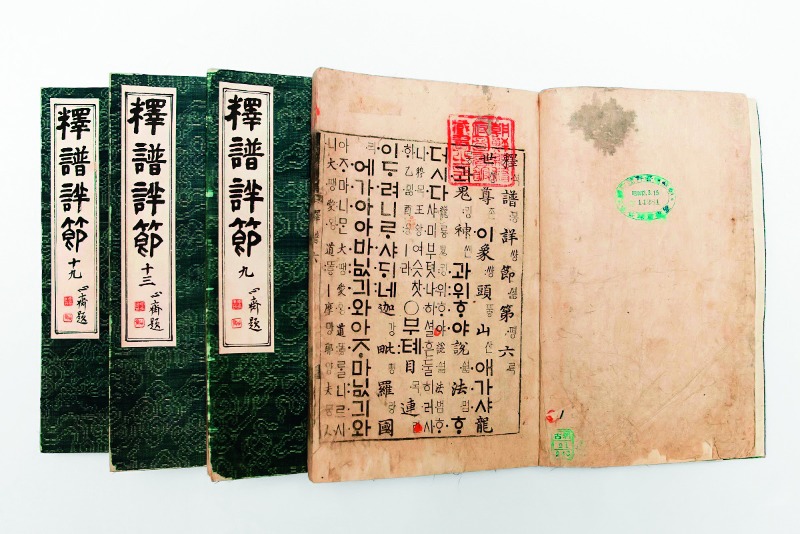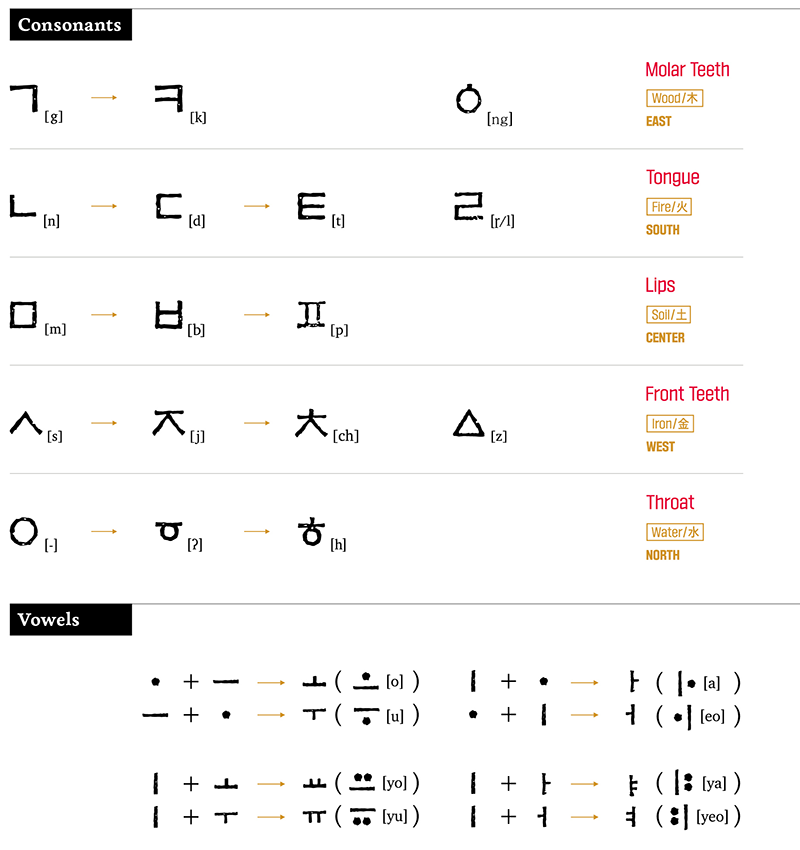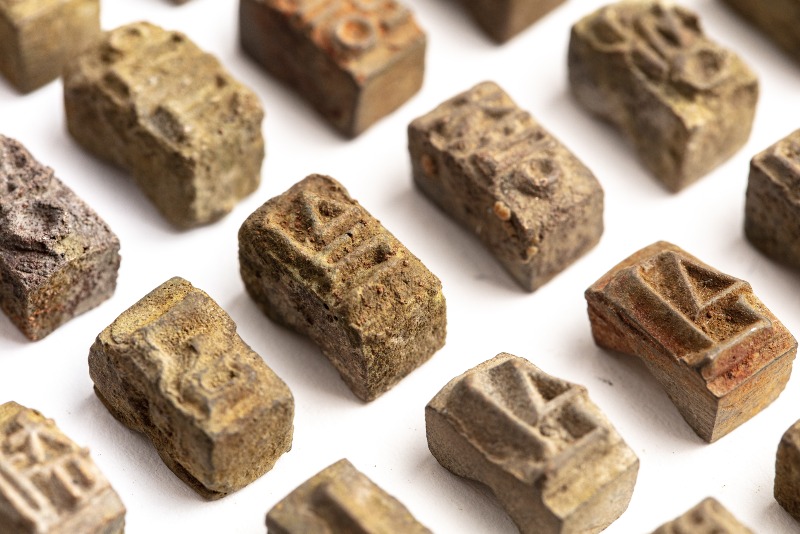Hangeul is a well-organized, systematic alphabet, with letters in shapes that correlate to spoken Korean. The first to have a syllable structure featuring an initial consonant, middle vowel and final consonant, it was invented for the masses to easily learn and use in their daily lives.

King Sejong (r. 1418-1450), the fourth ruler of the Joseon Dynasty and the most revered Korean monarch, invented Hangeul and launched a cultural renaissance during his reign. A statue of the sage king, 6.2 meters tall and 4.3 meters wide, dominates Gwanghwamun Square, the heart of Seoul, in front of Gyeongbok Palace.
© Ha Ji-kwon
The proclamation of Hangeul in 1446 not only led to near-universal literacy in Korea, it allowed for spoken and written Korean to finally align. This phonetic alphabet would eventually end the use of Chinese , a writing system that separated the elite from ordinary people, due in part to pervasive mismatches with the spoken language.
King Sejong (r. 1418-1450), the fourth monarch of the Joseon Dynasty, committed himself to creating an alphabet that would be quick and easy to learn and use in the context of everyday matters of ordinary people – not just royal and scholarly papers of the learned nobility. Thus, Hangeul is among a rare group of writing systems whose time and purpose of creation, as well as its creator, are known. Meanwhile, the social background that necessitated Hangeul’s invention and the principles governing its syllable structure distinguish it from other major s.
Originally, the Korean alphabet was named Hunminjeongeum, meaning the “correct sounds to instruct the people,” which was also the name of the first document that explained the principles and usage of the . The current name, Hangeul, was coined in 1912 by a Korean linguist. Han (한) means “great” and is commonly used to refer to Korea; geul geul(글) means “.” The name therefore means “Korean .” The 24 letters of the alphabet (14 consonants and 10 vowels) came from an original group of 28 (17 consonants and 11 vowels). These are phonetic and designed to mimic the positions of the mouth when speaking Korean. The writing system is both alphabetic and syllabic.
From Logography to Phonography
A writing system cannot exist apart from a spoken language. The former is defined in relation to the latter. Some components of a spoken language, such as phonemes and syllables, correspond to sounds with no reference to meaning. This entails phonography. Other components, like morphemes and words, have specific sounds as well as meanings. This involves logography.
In the phonographic Hangeul , “ㄱ” and “ㅏ” represent a consonant and a vowel, respectively, but have no meaning in and of themselves. In contrast, in the logographic Chinese , “首” corresponds to the spoken word that connotes “leader” or “head.” When combined with the character for city, the word becomes “首都” (capital), pronounced “shǒudū.” The first letter retains its meaning. On the other hand, characters can also have a phonetic purpose, as in the first half of “首尔” (“shǒu’ěr”), a spelling of Seoul, devised to closely resemble its Korean pronunciation. This shows that letters of a logogram may also be used phonographically, if need be, and this exceptional usage is called a rebus.

“Episodes from the Life of Sakyamuni Buddha” (Seokbo sangjeol), Vol. 6, 9, 13, 19. 1447. Metal type print. Collection of the National Library of Korea.At the request of King Sejong, his second son, Prince Suyang (who would be King Sejo), compiled this biographical account of the historical Buddha and summary of his sermons, based on Buddhist sutras written in Chinese. Published in memory of Queen Soheon, who died in 1446, this is the first known book fully written in the Korean after its creation.
© National Library of Korea
Evolution of Writing Systems
Most s throughout history began as logography. Initially, logograms were used both logographically and phonographically, but the latter usage gradually prevailed over time, giving rise to phonography.
The Phoenician alphabet, which was derived from Egyptian hieroglyphs, became phonographic before it spread. Moving westward to Europe, it evolved into the Greek, Cyrillic and Latin s; as it spread eastward, it evolved into the Hebrew and Arabic s. Here we can observe a common tendency in the development of phonetic alphabets. The Hebrew and Arabic s employed an abjad, a writing system in which consonants were marked primarily and vowels secondarily. The abjad of Western Asia moved into India and evolved into an abugida, a system in which default vowels are not written down when following consonants, and other vowels are denoted by the addition of diacritic marks. Some Tibetan s were also abugidas, but with slightly more independent vowels. Later on, vowels were separated from consonants in the ’Phags-pa , which was devised by a Tibetan monk for the Mongol-led Yuan Dynasty. It was halfway between an abugida and an alphabet – the latter assigning completely equal status to vowels and consonants.
Vowels became more distinct in the s that evolved as writing systems progressed further into the Asian continent. Hangeul became the most extreme example of this tendency, resulting in a complete alphabet.
Invention of Hangeul
The creators of today’s major s from around the world tend to be unknown because these s evolved and spread over long periods of time. Hangeul is an exception. The period of its development is clearly defined and its inventor is known, although there are theories about his assistants.
It is widely presumed that the Korean alphabet was created by a group of scholars working for Jiphyeonjeon, or the Hall of Worthies, the Joseon Dynasty’s royal research institute. However, a comprehensive examination of historical literature makes it highly plausible that Hangeul was in fact a personal creation of King Sejong alone.
In the palace records of state affairs and the activities of kings, “The Annals of the Joseon Dynasty,” an entry dated to the 12th month of the 25th year of King Sejong’s reign makes brief mention of the king’s invention of the native . This is the first written record about Hangeul. If the king had worked with scholars from the royal research institute, that process would have been documented in the court annals. But as there is no mention of any such collaboration, it is therefore presumed that the king worked alone in secret, probably because his court advisors would have opposed the project.
Since King Sejong was well versed in Chinese phonology, he must have been capable of working on his own, analyzing the sounds of spoken Korean as well as the characteristics and interrelations of its phonemes. It could be concluded, then, that scholars were not involved until later, when it came time to publish books using the newly invented .
“Song of the Moon’s Reflection on a Thousand Rivers” (Worin cheongang ji gok), Vol. 1. Metal type print. 1447. Collection of MiraeN Textbook Museum.This is a collection of poems composed by King Sejong, praising the virtuous deeds of Sakyamuni Buddha. It was designated a National Treasure in 2017.
© Courtesy of MiraeN Textbook Museum and Cultural Heritage Administration
Principles of the New
The basic unit of Hangeul corresponds to the spoken phoneme. Vowels and consonants have equal value. This is also true for Latin, but in other s, including Latin, phonemic similarity does not ensure likeness in the shapes of the corresponding letters.
In the Latin alphabet, the standard used in the English language, p and b are bilabial, t and d alveolar, and k and g velar. As shown in these pairs, letters whose sounds are articulated in the same place do not necessarily look alike. There is no similarity in shape between the voiceless (p, t, k) and voiced (b, d, g) letters, either. In Hangeul, however, the shapes of the letters are similar: ㅁ, ㅂ, ㅍ, ㅃ (bilabial); ㄴ, ㄷ, ㅌ, ㄸ (alveolar); and ㅇ, ㄱ, ㅋ, ㄲ (velar).
There is also a correlation between the shapes and the mode of articulation: nasal (ㅁ, ㄴ, ㅇ), plain obstruent (ㅂ, ㄷ, ㄱ), aspirated (ㅍ, ㅌ, ㅋ), and glottalized (ㅃ, ㄸ, ㄲ). Adding a stroke to nasal consonants creates plain obstruent consonants (ㅁ→ㅂ, ㄴ→ㄷ), and adding an additional stroke to these makes aspirated consonants (ㅂ→ㅍ, ㄷ→ㅌ, ㄱ→ㅋ). Plain obstruent consonants can also be turned into glottalized consonants by writing the same letter twice (ㅂ→ㅃ, ㄷ→ㄸ, ㄱ→ㄲ). The correlation between these different consonant groups is reflected in the shapes of the letters, an uncommon feature among other s.

This table illustrates the principles behind the construction of Hangeul letters. The five basic consonants (ㄱ, ㄴ, ㅁ, ㅅ, ㅇ), designed to mimic the vocal organs used to articulate them – the molar teeth, tongue, lips, front teeth and throat, respectively – have strokes added to create more letters. The three basic components of vowels, modeled after heaven (ㆍ), earth (ㅡ) and humans (ㅣ), are combined in various ways to represent different sounds.
Vowels became more distinct in the s that evolved as writing systems progressed further into the Asian continent. Hangeul became the most extreme example of this tendency, resulting in a complete alphabet.

These are some of the more than 600 pieces of Hangeul metal type excavated in June 2021 in Insa-dong, central Seoul. Over 1,600 pieces of metal type produced in the early Joseon Dynasty were found during an excavation and survey preceding an urban redevelopment project. They feature letters from the earliest version of the alphabet. Other findings from the same site included parts of a sundial and a water clock, both presumably made during King Sejong’s reign, and some firearms dating back to the late 15th or 16th century.
During the Joseon Dynasty, many government offices were located in Insa-dong, near Gyeongbok Palace. The relics were probably buried in earthenware jars sometime after 1588. Out of the six distinct occupation layers identified in the area, the relics were found in the lowest stratum, some 3 meters below ground.
© Cultural Heritage Administration
Adoption and Proliferation
For a long time, the elite class dismissed Hangeul as unworthy and continued to use the Chinese as their primary means of written communication. Gradual adoption and dissemination of the native alphabet is largely credited to women, Buddhism and novels.
In the pre-modern era, women, including those in the ruling class, had little access to formal education. The simplicity and efficiency of Hangeul meant they could now communicate easily. Mothers and their married daughters usually exchanged letters written in Hangeul. The was also used in letters between couples such as a nobleman (called “yangban”) working out of town and his wife back at home, who could not write in the Chinese as her learned husband could. Such letters provide valuable information on earlier forms and usages of Hangeul, as well as the lives of contemporaneous Koreans.
Meanwhile, the Buddhist community translated ures written in Chinese into Korean in order to propagate the Buddha’s teachings among as many people as possible. The Joseon Dynasty officially suppressed Buddhism and upheld Confucianism as its state ideology. Nevertheless, quite a few royal family members practiced Buddhism and patronized the publishing of ures.
And in the late Joseon Dynasty, men and women from all walks of life began to enjoy reading novels. Early on, novels were hand-copied and shared, or storytellers would dramatically read them out loud to groups of listeners. Soon, more and more people sought to learn Hangeul, wanting to read novels for themselves. From the 18th to the early 20th century, active circulation of novels and a growth in the literate population had a significant influence on the propagation of Hangeul.
Park Jin-ho Professor of Korean Language and Literature, Seoul National University